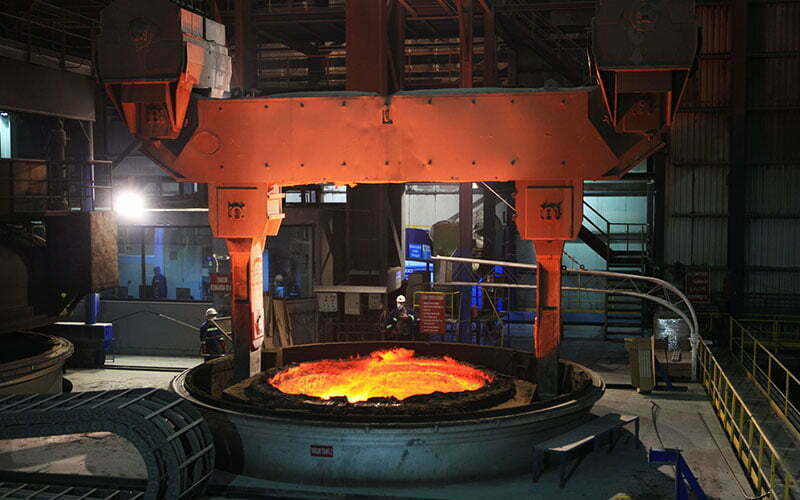Ladle furnace refining technology research began in 1968. At that time, it was discovered that the reduction and refining effect of prefabricated reduction slag, mixed steel slag, and argon blowing treatment in the electric arc furnace was significant. Therefore, the development of a ladle refining technology with the electric arc heating function for the purpose of omitting the reduction period of the electric arc furnace was carried out. In 1971, the first ladle refining furnace (LF) of Japan’s Datong Special Steel Plant was put into use. In 1973, LF was installed at the converter plant of Nippon Steel Yawata Steel.
EAF process and converter process commonly used post-tap slag treatment process, namely: electric arc furnace or converter tapping → LF refining (aluminum, slag, Ca-Si or slag modification agent) → casting
Product description:
The Ladle furnace is installed in the electric arc furnace steelmaking plant, which reduces the reduction time of the electric arc furnace, and finally cancels the reduction period of the electric arc furnace. It shortens the smelting cycle of the electric arc furnace, improves the productivity of the electric arc furnace, and provides consistent casting for a certain period of time. The molten steel with temperature, composition and cleanliness requirements ensures the antegrade of the electric arc furnace + LF refining + continuous casting process, making the electric arc furnace developed into a high-efficiency short-process steelmaking method that can produce ordinary steel grades from ordinary scrap and pig iron, Rather than just equipment for producing high-quality steel grades. The first stage of electric arc furnace development is the traditional electric arc furnace including melting, oxidation and reduction. The second stage is due to the type of electric arc furnace (tapping trough type electric arc furnace). In order to avoid the oxidized slag from polluting the molten steel and the deoxidation and desulfurization of the steel slag, the reduced slag must be made in the electric arc furnace. The steel slag is mixed, and LF will complete the task of further reduction and refining. The third stage is due to the development of slag-free tapping technology, and the reduction period is all completed by LF refining, which forms the form of modern electric arc furnace steelmaking process EAF+LF+CC.
The ladle furnace is used in the converter process to produce special steel, eliminating the past steelmaking method to distinguish steel quality, and establishing the idea of ”primary smelting (electric furnace or converter) + LF refining + continuous casting” to produce multi-variety, high-quality steel. After the successful development of LF technology, it has developed in the direction of multi-function. In 1981, the NK-AP method was developed at the Fukuyama Steel Works of Japan. LF for vacuum equipment.
Because of the simple structure of LF equipment, it has a variety of metallurgical functions, flexibility in use, significant refining effects, and high economic benefits. It has become an important piece of equipment in the steel production process.
Process analysis:
LF ladle furnace refining is one of the main methods of refining outside the furnace, and its key is to quickly produce white slag. The purpose of LF slagging is to desulfurize, deoxidize, increase alloy yield, and remove inclusions. However, in the slagging process of aluminum-controlled steel, there are certain contradictions between desulfurization and silicon recovery, nitrogen increase, and inclusion removal, and overall consideration is needed. In LF, it can quickly and stably produce reducing white slag with good fluidity and certain emulsification, which is necessary for LF desulfurization, adsorption of inclusions and ensuring the quality of molten steel.
Taking the European standard S235JR aluminum-controlled steel (low silicon steel grade) as an example, the production process is combined by blowing converter → argon station → LF → CC. When the converter is tapping, use the kinetic energy of stirring during tapping, add the proper amount of lime to wash the slag to pre-form the reduced slag to ensure the alkalinity and prevent the return of phosphorus and silicon; the whole process of tapping is softly stirred and the composition and temperature are uniform; steel core aluminum ( (Or aluminum, manganese, magnesium) for molten steel deoxidation; according to the amount of slag (generally about 5kg/t), add an appropriate amount of modifier in time after tapping; use high-carbon manganese for alloying.
Through the analysis of slag making process, slag composition transformation process, slag comprehensive alkalinity change, etc., the following technical measures for rapid white slag making are obtained:
(1) The converter tapping slag is modified in advance, which can provide favorable conditions for LF rapid slagging; at the same time, the converter tapping should also be strictly controlled: supplementary blowing, slag blocking, bottom blowing, package condition, and one-time deoxidation.
(2) Rapid slagging in the early stage is the prerequisite for slagging. Control points: rapid heating, submerged arc, stirring, and reasonable addition of slag-making agent in batches.
(3) Strong stirring desulfurization (4.0~6.0L/(min·t)), the speed should be fast, and the time should be short. While ensuring desulfurization, try to control the time of secondary oxidation and liquid steel nitrogen absorption. Generally, it is completed within 10-20 minutes after the LF starts to process. This stage is the main stage of LF refining.
(4) After the desulfurization is completed, the main tasks of LF are temperature control, alloying and removal of inclusions. At this stage, the viscosity of the slag and the stirring intensity must be controlled within 0.5~1.0L/(min·t) (with liquid level fluctuation but not exposed The steel liquid level is the principle), and the holding time is required to be greater than 8min.

